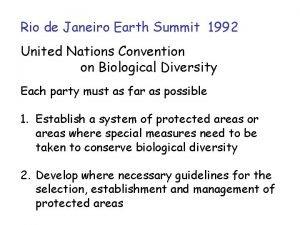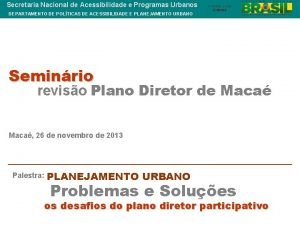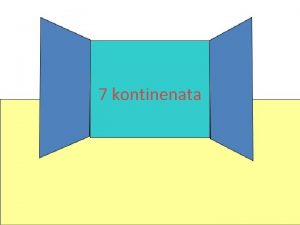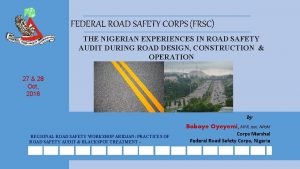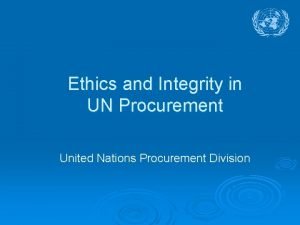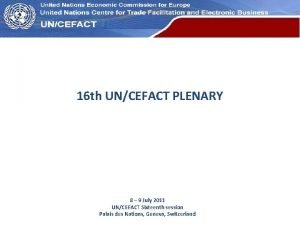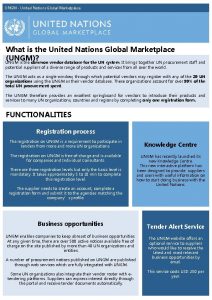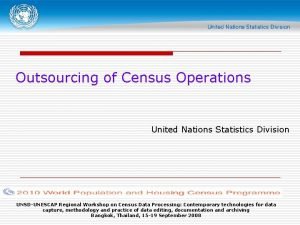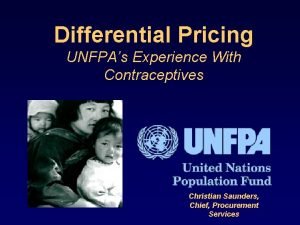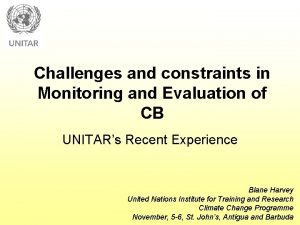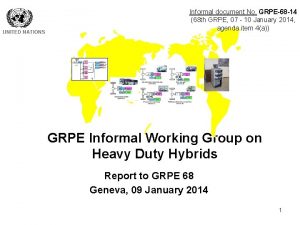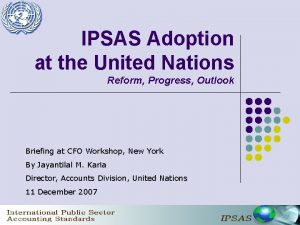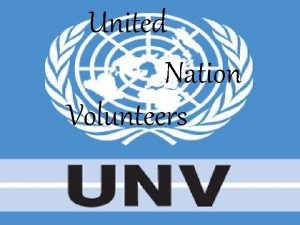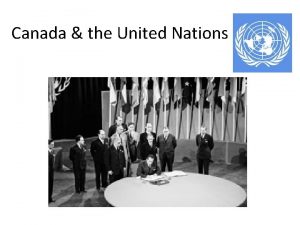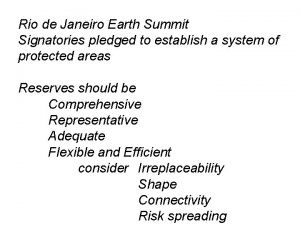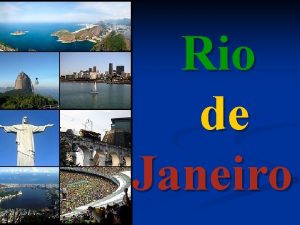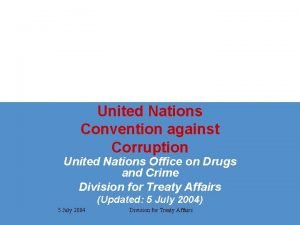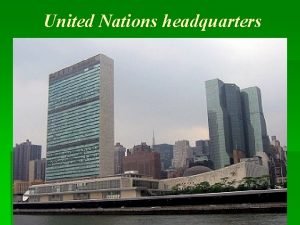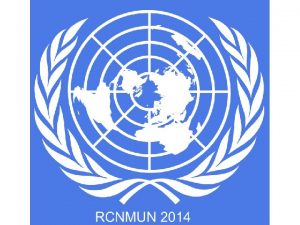Rio de Janeiro Earth Summit 1992 United Nations





























- Slides: 29

Rio de Janeiro Earth Summit 1992 United Nations Convention on Biological Diversity Each party must as far as possible 1. Establish a system of protected areas or areas where special measures need to be taken to conserve biological diversity 2. Develop where necessary guidelines for the selection, establishment and management of protected areas

Protected areas and reserve design Overview Goals and limitations Gaps in global protected areas Systematic conservation planning Surrogates for overall biodiversity Reserve selection algorithms Case study: The Cape Floristic Region

terrestrial protected areas 105, 000 protected areas 18. 4 million km 2 land

Location of protected areas 12. 65% of Earth’s land surface

Cumulative area protected (ha) marine protected areas but only 1. 2% of the whole ocean!!!

Types of Protected Areas IUCN Category 1 2 3 4 5 6 Strict nature reserve or wilderness area National Park Natural Monument Habitat/Species Management Area Protected landscape/seascape Managed resource protected area

Types of Protected Areas BC Examples Strict nature reserve 1 a Triangle Island Wilderness area 1 b Campbell River Estuary

Area (km 2) covered by protected areas 1 -6 Global Canada 630, 000 km 2 6. 3% land 1+2 72% 3 -5 10% 6+ 18%

Types of protected area 6. Managed resource protected area Ngorongoro Crater, Tanzania

Goals of Protected areas Protect particular species Preserve biodiversity: focus on areas of high species richness/endemism Preserve large and functioning ecosystems and their services

Percent natural vegetation Do protected areas work? Amazon Congo forest Joppa et al PNAS 2008 Atlantic coast forest West African forest

Do marine protected areas work? Overall effect of 12 reserves around the world 6 Response 5 ratio 4 More fish 3 in reserve 2 1 More fish 0 out of -1 reserve (541) (236) (110) Target species Non-target species Overall Mosqueira et al. 2000 Animal Conservation

Limitations of protected areas Land is often protected if it is “worthless” BC 1992 Stated Goal - have 12% landbase “protected” 2006 12. 5% landbase is protected BUT Alpine - over-represented Coastal lowland forest - under-represented

Limitation of protected areas Protection is revoked if land is valuable” Tasmania 1939 -1984 23 protected areas “unprotected” Why? forestry, mining, hydroelectric development Yosemite National Park 1904 Boundaries redrawn Land out - potential mining, logging, grazing Land in - low commercial value

What isn’t protected? ? Global Gap Analysis Project Data World Database on Protected Areas Distributions of 11, 633 spp vertebrates

x x X - least protected biomes x

What isn’t protected? ? Global Gap Analysis Project Number of gap species All PAs PA>1000 ha+IUCN 1 -4 Mammals 258 (5. 5%) 644 (13. 5%) Turtles 21 (7. 7%) 48 (17. 6%) Amphibians 913 (16. 7%) 1718 (31. 5%) Threatened spp Mammals 149 (14%) 314 (29. 6%) Birds 232 (19. 8%) 437 (37. 3%) Turtles 12 (10. 1%) 32 (26. 9%) Amphibians 411 (26. 6%) 767 (49. 7%)

Where are the Gap Species? Global Gap Analysis Project

% gap species The area protected in a country is a poor predictor of conservation needs Countries with lots of endemics have more gap species

What isn’t protected? ? Local Gap Analysis - Hawaii - Essay 14. 2 text GIS parks + Endangered finch distributions --> Hakalau Forest National Wildlife Refuge

What should be protected? How would you prioritize what/where is Protected given constraints on $$/current land-use/other pressures Your criteria

Systematic conservation planning 9 principal factors to consider COMPREHENSIVENESS Reserve system contains Many species Many habitats Many ecological processes REPRESENTATIVENESS Reserve contains populations/habitats that cover range of variation in that spp/habitat

Systematic conservation planning IRREPLACEABILITY Importance of an area in meeting the objectives of the reserve system hairy-nosed wombat Located in one place Epping Forest National Park if criteria is a system that retains all mammal species the area is irreplaceable

Systematic conservation planning ADEQUACY Features within reserve will persist Q. How might this be assessed? SHAPE large with low edge: area ratios Q. why? Better than

Systematic conservation planning CONNECTIVITY for animals gene flow, greater area response to climate change for ecosystem processes eg water flow, fire RISK SPREADING connectivity vs vulnerability

Systematic conservation planning EFFICIENCY least possible cost (purchase, management, economic loss) FLEXIBILITY options/opportunities

Global Gap Analysis Project if conservation goal is species representation we should also consider urgency = threat

Global Gap Analysis Project Priority sites for protected areas based on irreplaceability and threat

Principal of comprehensiveness requires that reserve systems include and sustain all biodiversity and ecosystem processes of the region But - the knowledge base is limited and DECISIONS ARE NEEDED NOW OPTIONS? DISCUSS
 Earth summit 1992
Earth summit 1992 Cemitério das polacas rio de janeiro
Cemitério das polacas rio de janeiro Planejamento urbano rio de janeiro
Planejamento urbano rio de janeiro Riu de janeiro
Riu de janeiro Kontinent 7
Kontinent 7 Okręg przemysłowy minas gerais
Okręg przemysłowy minas gerais Accessrio
Accessrio Zigurates
Zigurates Frsc vision and mission statement
Frsc vision and mission statement Ethics and integrity at the united nations
Ethics and integrity at the united nations Unicef
Unicef United nations staff union
United nations staff union United nations
United nations United nations economic commission for europe
United nations economic commission for europe What is ungm
What is ungm United nations statistics division
United nations statistics division Christian saunders united nations
Christian saunders united nations Constraints in monitoring and evaluation
Constraints in monitoring and evaluation Introduction to model united nations
Introduction to model united nations Class 7 dangerous goods
Class 7 dangerous goods United nations
United nations What is mun
What is mun Six main organs of the united nations
Six main organs of the united nations Junior model united nations
Junior model united nations United nations flag
United nations flag United nations zambia
United nations zambia Ipsas united nations
Ipsas united nations United nations
United nations Uno flag
Uno flag Introduction of united nations
Introduction of united nations
